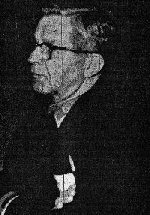4/8/1963, Newsweek
GODDARD AT 25
The sweet, heavy odor of boilng sap
rose last week in the weather-beaten
sugarhouse of Goddard College outside
Plainfield, Vt. Boys and girls, working in
shifts through the night, stirred steaming
vats with big wooden ladles. Goddard,
which celebrates its 25th anniversary
this year, offers no academic credit for
the chores students do on its hilly
200-acre campus, but the college does
get about $40,000 worth of labor
from them every year. That still doesn't
make ends meet; it costs Goddard $3,100
a year to educate each undergratuate,
and no one pays more than $2,600 to
go there. But the money helps, and
more important says Goddard president
Royce S. Pitkin, "it gives the students
a feeling that the college is theirs."
Few colleges strive so hard to foster
that feeling. President Pitkin, 61,
is "Tim" to everyone on the Goddard campus -
220 students, two dozen teachers,
and the paid help in the kitchen (whose
names are listed in the college catalogue).
Goddard does insist that everybody
must complete at least one independent-study
project before graduation, but what and when are
entirely up to the students.
To make its hands-off philosophy work,
Goddard tries to interview every student,
looking for qualities that don't show up on
college-board examinations: independence,
maturity, eagerness to learn (in Goddard's
first year, one boy signed up for
eleven courses; the next year the school
regretfully imposed a more realistic three-course
limit). Even with the interviews, though,
Goddard sometimes misses. Although 40 per cent of
its graduates go on to further schooling (with a
heavy concentration in teaching and social work),
almost half the students who come to Goddard
drop out before graduation - often to
migrate to another school that imposes
more external discipline.
But if Goddard's student-centered
permissiveness can lead to abuses, it can
also yield brilliant results. Alex Rodriguez was
a street-gang boy from South Brooklyn when he first visited Goddard,
but he had sampled higher education
at New York's Hunter College ("I didn't dig the setup there very much")
and Goddard left him incredulous ("I
didn't consider this a School"). But Alex
enrolled anyway, and by his second year
he felt ready for an independent project:
a study of drug addiction in his
own neighborhood, among members of
his old gang.
Guided by sociology teacher Jerome
Himelhoch, a former Rhodes scholar,
Alex and an older student, Joe
McEntyre, plowed through the literature
of addiction. "I think we got every book
that was written at the time," Alex says.
Then, armed with a tape recorder, the
boys headed for South Brooklyn. Working twelve hours a day for more than
a week, they interviewed elusive junkies
("You hadda get 'em after they had a
shot") and non-addicts as well (use of
marijuana didn't count "because every-
body used it"). Their findings, set out
in a 60 page paper, were provocative
enough to be read to the Eastern Sociological
Society last year. [While not conclusive,
the evidence supported the so-called
'double-failure' theory, which holds
that addicts are the rejects of an
underworld social system peopled
mainly by other failures from
'legitimate' society.]
First Collegians: For all its
unorthodoxy now, Goddard came late to
the ferment of educational experiment
between world wars. It was just an
obscure private high school, chartered
in 1863 by liberal-minded Universalists,
until Vermont-born, Goddard-educated
Tim Pitkin turned it into a college in
1938. When the first 48 collegians
moved into the brown-shingled farm
buildings outside of Plainfield, the biggest
innovations of that progressive era
had already been tried out elsewhere.
Goddard tried them, too: off-campus
work terms, student-dominated community
government, deep-probe counseling -
these innovations and more were imported
from the likes of Antioch, Sarah
Lawrence, and Bennington. Accreditation
came hard; Goddard flunked twice
before the New England Association
of Colleges and Secondary Schools
surrendered to its stubborn independence.
But lately the educational establishment
has been more generous; in the past
six years Goddard has gained $500,000
in grants - including a big one from the
Ford Foundation for the same kind of
way-out curricular tinkering that once left
accreditors aghast.
Gloomy Speculations:
The Ford grant is symptomatic; way-out shcools
are now solidly in - and they worry about it.
To celebrate its 25th anniversary, Goddard
called a conference this past winter on the future
of experimental colleges. With the snow 2 feet deep
and the temperature 15 below, top administrators
from a dozen colleges converged on Goddard to share
gloomy speculations. President William Fels of Bennington
sketched the duties set for him by his college's
graduates: "To see that Bennington does not change
in any respect - and to see that it remains an
experimental college." Later he came back to the
same point. "Aren't the big bad colleges the
really experimental ones now?" he wondered. "Are
the classic experimental colleges now conservative
forces?"
Under gray-haired Tim Pitkin, Goddard is facing up
to that question with calm Yankee practicality. Goddard
no more wants to be big than bad, but it is growing;
next fall enrollment will rise to 265, and soon it will
level off at 350. The problem, as Pitkin forumlates
it in his crackling Vermont speech, is to provide the
kind of person-to-person treatment Goddard students get
now. "How", he asks, "is the education of the masses
of students to be achieved with real education for
the individual?" It is the problem of American
eduction today, and no college will go farther
than Goddard in search of a solution.

Pitkin: not big, not bad

